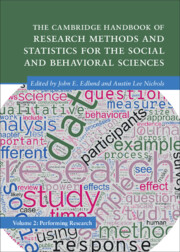 The Cambridge Handbook of Research Methods and Statistics for the Social and Behavioral Sciences
The Cambridge Handbook of Research Methods and Statistics for the Social and Behavioral Sciences Book contents
- The Cambridge Handbook of Research Methods and Statistics for the Social and Behavioral Sciences
- Cambridge Handbooks in Psychology
- The Cambridge Handbook of Research Methods and Statistics for the Social and Behavioral Sciences
- Copyright page
- Dedication
- Contents
- Figures
- Tables
- Contributors
- Preface
- Part I Quantitative Data Collection Sources
- Part II Important Methodological Considerations
- Part III Self-Report Measures
- Part IV Behavioral Measures
- Part V Physiological Measures
- Part VI Qualitative Data Collection Sources
- 24 Open-Ended Survey Questions
- 25 Qualitative Archival Data: A Call to Creativity
- 26 Interviews: Processes, Strategies, and Reflections
- 27 Case Studies: A Personal Account of Choices and Dilemmas
- 28 Focus Groups
- 29 Observational Data
- Index
- References
29 - Observational Data
from Part VI - Qualitative Data Collection Sources
Published online by Cambridge University Press: 12 December 2024
- The Cambridge Handbook of Research Methods and Statistics for the Social and Behavioral Sciences
- Cambridge Handbooks in Psychology
- The Cambridge Handbook of Research Methods and Statistics for the Social and Behavioral Sciences
- Copyright page
- Dedication
- Contents
- Figures
- Tables
- Contributors
- Preface
- Part I Quantitative Data Collection Sources
- Part II Important Methodological Considerations
- Part III Self-Report Measures
- Part IV Behavioral Measures
- Part V Physiological Measures
- Part VI Qualitative Data Collection Sources
- 24 Open-Ended Survey Questions
- 25 Qualitative Archival Data: A Call to Creativity
- 26 Interviews: Processes, Strategies, and Reflections
- 27 Case Studies: A Personal Account of Choices and Dilemmas
- 28 Focus Groups
- 29 Observational Data
- Index
- References
Summary
Observational data are valuable for many research studies across different fields and can be appropriate for various studies, including qualitative, quantitative, and mixed methods research. Observations can be structured, semi-structured, or unstructured and are often combined with other methods such as interviews and documentary analysis. In this chapter, we focus on the practical aspects of observational data, including identifying appropriate settings and gaining access, determining the role of the observer and the level of participation during observation, and planning how the data will be collected, recorded, and analyzed. We also emphasize the role of reflexivity – an important tool for the observer to ensure they are aware of how they are influencing the data observed. Although there are many benefits to observation as a data collection method, there are also challenges, limitations, and ethical issues to address; all these areas will be considered in this chapter.
- Type
- Chapter
- Information
- The Cambridge Handbook of Research Methods and Statistics for the Social and Behavioral SciencesVolume 2: Performing Research, pp. 665 - 685Publisher: Cambridge University PressPrint publication year: 2024
